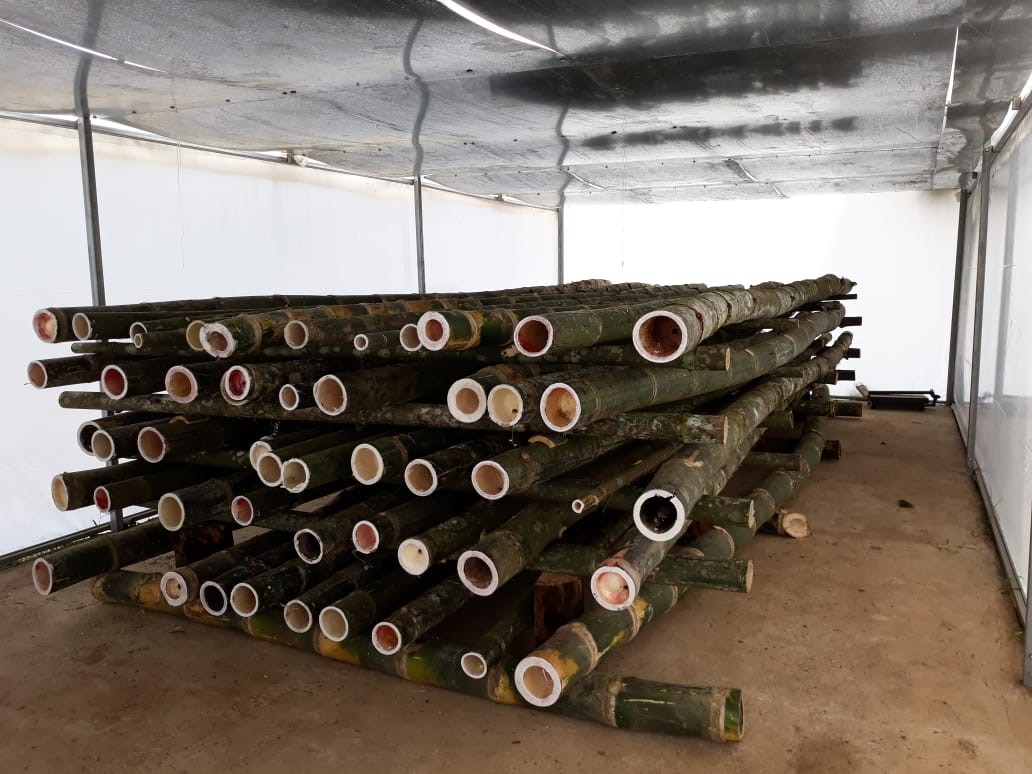Evaluation of the solar drying process of Guadua aculeata Rupr. ex E. Fourn. culms
DOI:
https://doi.org/10.29298/rmcf.v14i78.1384Keywords:
Drying curve, moisture content, exponential function, drying rate, tunnel type solar dryerAbstract
The moisture content of freshly harvested bamboo culms is high, near 100 %, and it should be reduced by some drying process. A key step in the processing of culms, which has been under-appreciated by bamboo producers and users, is drying. Outdoor exposure is the most widely used drying method in Mexico; however, it is not very efficient, as it takes weeks to several months, depending on the environmental conditions. The objective of the present study was to evaluate the drying of Guadua aculeata culm sections (6 m long) in a solar tunnel dryer with a rectangular prism shape. The initial average moisture content was 106.72 %, and after a period of 80 days, a final average moisture content of 29.84 % was reached. The drying rate was above 1.0 % per day in the first 20 days, during which their moisture content was reduced by approximately 40 %. In the following 60 days, they lost on average 37.41 % of moisture, at a variable drying rate for each sample crop. The drying curve of the assessed method corresponds to an exponential function. Under the experimental drying conditions, it was determined that 6 m long sections of culms with an average diameter of 12.42 cm can reach an average MC below 18 % in 109 days, thus becoming suitable for use as structural elements.
Downloads
References
Aquino-González, L. V., J. Rodríguez-Ramírez, L. L. Méndez-Lagunas y S. Sandoval-Torres. 2010. Evaluación de programas de secado para madera de chalamite (Pinus pseudostrobus). Madera y Bosques 16(2):35-46. https://www.scielo.org.mx/pdf/mb/v16n2/v16n2a3.pdf. (20 de mayo de 2023). DOI: https://doi.org/10.21829/myb.2010.1621171
Baranski, J., A. Suchta, S. Baranska, I. Klement, T. Vilkovská and P. Vilkovský. 2021. Wood moisture-content measurement accuracy of impregnated and nonimpregnated wood. Sensors 21(21):7033. Doi: 10.3390/s21217033. DOI: https://doi.org/10.3390/s21217033
Burger, M. D., G. A. Oosthuizen, J. F. Oberholzer, P. De Wet and C. I. Ras. 2017. Strategies to standardise bamboo for manufacturing process chains. Procedia Manufacturing 8:330-337. Doi: 10.1016/j.promfg.2017.02.042. DOI: https://doi.org/10.1016/j.promfg.2017.02.042
Canavan, S., D. M. Richardson, V. Visser, J. J. Le Roux, M. S. Vorontsova and J. R. U. Wilson. 2017. The global distribution of bamboos: assessing correlates of introduction and invasion. AoB Plants 9(1):1-18. Doi: 10.1093/aobpla/plw078. DOI: https://doi.org/10.1093/aobpla/plw078
Cedeño V., A. y J. Irigoyen C. 2011. El bambú en México. Revista Arq.urb 6:223-243. https://revistaarqurb.com.br/arqurb/article/view/317. (20 de enero de 2023).
Chaowana, K., S. Wisadsatorn and P. Chaowana. 2021. Bamboo as a sustainable building material-culm characteristics and properties. Sustainability 13(13):7376. Doi: 10.3390/su13137376. DOI: https://doi.org/10.3390/su13137376
Chen, Q., Y. He, Y. Jiang, J. Qi, … and J. Xie. 2023. Effect of bamboo nodes on crack generation of round bamboo and bamboo-based composites during drying. European Journal of Wood and Wood Products 81(2). Doi: 10.1007/s00107-023-01942-7. DOI: https://doi.org/10.1007/s00107-023-01942-7
Hartono, R., A. H. Iswanto, T. Priadi, E. Herawati, … and I. Sumardi. 2022. Physical, chemical, and mechanical properties of six bamboo from Sumatera Island Indonesia and its potential applications for composite materials. Polymers 14(22):4868. Doi: 10.3390/polym14224868. DOI: https://doi.org/10.3390/polym14224868
Hossain, M. A., M. A. Rahman, U. K. Rokeya and R. Akther. 2021. Application of solar heated kiln for determination of seasoning schedule of borak (Bambusa balcooa), baijja (Bambusa vulgaris) and dolu (Schizo stachyum) round bamboo species. Eco-friendly Agriculture Journal 14(3):9-13. http://efaj-international.com/wp-content/uploads/2021/04/002_21_BFRI_Seasoning-Scheduleof-Bamboo.pdf. (10 de noviembre de 2022).
Hox, J., M. Moerbeek, and R. van de Schoot. 2017. Multilevel analysis: Techniques and applications. Routledge Taylor & Francis Group. New York, NY, United States of America. 364 p. DOI: https://doi.org/10.4324/9781315650982
Huang, X. D., C. Y. Hse and T. F. Shupe. 2015. Study of moso bamboo's permeability and mechanical properties. Emerging Materials Research 4(1):130-138. Doi: 10.1680/emr.14.00034. DOI: https://doi.org/10.1680/emr.14.00034
International Organization for Standardization (ISO). 2019. NORM 22157:2019(en) Bamboo structures-Determination of physical and mechanical properties of bamboo culms-Test methods. ISO. Geneva, GE, Switzerland. 25 p. https://www.iso.org/obp/ui/#iso:std:iso:22157:ed-1:v1:en (24 de febrero de 2023).
Kaba, G., M. Mussa, G. Desalegn, A. Tesfaye, T. Wubishet and G. Mezgebu. 2022. Imperative seasoning characteristics of Yushania alpina (Highland bamboo) culms grown in Dire-Inchini, Ethiopia. Indonesian Journal of Innovation and Applied Sciences 2(3):247-254. Doi: 10.47540/ijias.v2i3.546. DOI: https://doi.org/10.47540/ijias.v2i3.546
Liese, W. and T. K. H. Tang. 2015. Preservation and Drying of Bamboo. In: Liese, W. and M. Köhl (Edits.). Bamboo: The Plant and its Uses. Springer International Publishing. Cham, ZG, Switzerland. pp. 257-297. DOI: https://doi.org/10.1007/978-3-319-14133-6_9
Londoño, X., G. C. Camayo, N. M. Riaño and Y. López. 2002. Characterization of the anatomy of Guadua angustifolia (Poaceae: Bambusoideae) culms. Bamboo Science and Culture: The Journal of the American Bamboo Society 16(1):18-31. http://www.bamboo.org/publications/e107_files/downloads/ABSJournal-vol16.pdf#page=20. (15 de diciembre de 2022).
Lv, H., C. Lian, B. Xu, X. Shu, J. Yang and B. Fei. 2022. Effects of microwave-assisted drying on the drying shrinkage and chemical properties of bamboo stems. Industrial Crops and Products 187:115547. Doi: 10.1016/j.indcrop.2022.115547. DOI: https://doi.org/10.1016/j.indcrop.2022.115547
Lv, H., M. Chen, C. Lian, H. Li, .. and B. Fei. 2021. Distribution and migration of moisture in round bamboo in response to microwave drying. BioResources 16(3):5915-5925. https://bioresources.cnr.ncsu.edu/resources/distribution-and-migration-of-moisture-in-round-bamboo-in-response-to-microwave-drying/ (20 de enero de 2023). DOI: https://doi.org/10.15376/biores.16.3.5915-5925
Lv, H., M. Chen, X. Ma, J. Li, … and B. Fei. 2018b. Effects of different drying methods on bamboo’s physical and mechanical properties. Forest Products Journal 68(4):445-451. Doi: 10.13073/FPJ-D-18-00009.
Lv, H., X. Chen, X. Liu, C. Fang, … and B. Fei. 2018a. The vacuum-assisted microwave drying of round bamboos: Drying kinetics, color and mechanical property. Materials Letters 223:159-162. Doi: 10.1016/j.matlet.2018.04.038. DOI: https://doi.org/10.1016/j.matlet.2018.04.038
Mehta, P., N. Bhatt, G. Bassan and A. E. Kabeel. 2022. Performance improvement and advancement studies of mixed-mode solar thermal dryers: a review. Environmental Science and Pollution Research 29(42):62822-62838. Doi: 10.1007/s11356-022-21736-3. DOI: https://doi.org/10.1007/s11356-022-21736-3
Montero, C. y C. Rozas. 2019. Estudio exploratorio para la caracterización de la tasa de secado de la madera de Eucalyptus nitens, aplicando modelos de regresión múltiple. Scientia Forestalis Piracicaba 47(121):105-113. Doi: 10.18671/scifor.v47n121.10. DOI: https://doi.org/10.18671/scifor.v47n121.10
Montoya A., J. A. y E. Jiménez A. 2006. Determinación de la curva de secado al aire libre, mediante modelación matemática y experimental de la Guadua angustifolia Kunth. Scientia et Technica 12(30):415-419. Doi: 10.22517/23447214.6593.
Morales-Pinzón, T., L. F. Durán y C. A. Alzate. 2012. Contenido de humedad en guadua rolliza preservada y secada en invernadero. Recursos Naturales y Ambiente (65-66):45-50. https://repositorio.catie.ac.cr/bitstream/handle/11554/7065/Contenido%20de%20humedad%20en%20guadua%20rolliza%20preservada%20y%20secada%20en%20invernadero.pdf?sequence=1&isAllowed=y#:~:text=En%20las%20muestras%20evaluadas%20de,entre%206%25%20y%2015%25. (6 de diciembre de 2022).
Ong, K. S. 1996. Experimental investigation of a solar bamboo dryer. Drying Technology An International Journal 14(10):2411-2417. Doi: 10.1080/07373939608917213. DOI: https://doi.org/10.1080/07373939608917213
Ordóñez C., V. R., M. T. Mejía S. y G. M. Bárcenas P. 2013. Manual para la construcción sustentable con bambú. Comisión Nacional Forestal (Conafor). Zapopan, Jal., México. 94 p. http://www.conafor.gob.mx:8080/biblioteca/descargar.aspx?articulo=506. (15 de noviembre de 2022).
R Core Team. 2022. The R Project for Statistical Computing (Version 4.2.3). Vienna, W, Austria. R Foundation for Statistical Computing. https://www.r-project.org/. (15 de febrero de 2023).
Ramírez-Ojeda, G., G. Orozco-Gutiérrez, L. Á. Barrera-Guzmán and E. Ruiz-Sanchez. 2021. Edaphoclimatic diversity and ecological descriptors of Guadua bamboo species (Poaceae: Bambusoideae) in México. International Journal of Agriculture, Environment and Bioresearch 6(3):228-244. Doi: 10.35410/IJAEB.2021.5641. DOI: https://doi.org/10.35410/IJAEB.2021.5641
Rezaei, M., M. Sefid, K. Almutairi, A. Mostafaeipour, … and K. Techato. 2022. Investigating performance of a new design of forced convection solar dryer. Sustainable Energy Technologies and Assessments 50:101863. Doi: 10.1016/j.seta.2021.101863. DOI: https://doi.org/10.1016/j.seta.2021.101863
Ruiz-Sanchez, E., C. D. Tyrrell, P. Carrillo-Reyes and A. T. Nuño-Rubio. 2022. A striking new species of Rhipidocladum (Poaceae: Bambusoideae: Bambuseae: Arthrostylidiinae) with single, terminal-spikelet synflorescences, endemic to Jalisco, Mexico. Plant Ecology and Evolution 155(3):417-424. Doi: 10.5091/plecevo.86519. DOI: https://doi.org/10.5091/plecevo.86519
Secretaría de Desarrollo Urbano y Vivienda (Seduvi). 2017. NTC2017 Normas técnicas complementarias para diseño y construcción de estructuras de madera. Gaceta Oficial de la Ciudad de México. 15 de diciembre de 2017. Ciudad de México, México. pp. 567-613. https://paot.org.mx/centro/normas_a/2022/6.pdf. (22 de febrero de 2023).
Simpson, W. T. 1991. Dry kiln operator's manual. United States Department of Agriculture and Forest Service. Madison, WIS, United States of America. 274 p. https://www.fpl.fs.usda.gov/documnts/usda/ah188/ah188.htm. (18 de mayo 2023).
Solargis. 2023. Global Solar Atlas. World Bank Group. https://globalsolaratlas.info/map. (15 de enero de 2023).
Tang, T. K. H., J. Welling, T. Ho and W. Liese. 2012. Investigation on optimisation of kiln drying for the bamboo species Bambusa stenostachya, Dendrocalamus asper and Thyrsostachys siamensis. Bamboo Science and Culture: The Journal of the American Bamboo Society 25(1):27-35. https://www.semanticscholar.org/paper/Investigation-on-optimisation-of-kiln-drying-for-Tang-Welling/d6fd5b445b94e3ebb48ec2205260082f301e1ee5. (15 de enero de 2023).
Vetter, R. E., R. A. Sá Ribeiro, M. G. Sá Ribeiro and I. P. A. Miranda. 2015. Studies on drying of imperial bamboo. European Journal of Wood and Wood Products 73:411-414. Doi: 10.1007/s00107-015-0900-6. DOI: https://doi.org/10.1007/s00107-015-0900-6
Wang, X., L. Song, D. Cheng, X. Liang and B. Xu. 2019. Effects of saturated steam pretreatment on the drying quality of moso bamboo culms. European Journal of Wood and Wood Products 77:949-951. Doi: 10.1007/s00107-019-01421-y. DOI: https://doi.org/10.1007/s00107-019-01421-y
Yan, Y., B. H. Fei and S. Q. Liu. 2022. The relationship between moisture content and shrinkage strain in the process of bamboo air seasoning and cracking. Drying Technology 40(3):571-580. Doi: 10.1080/07373937.2020.1819307. DOI: https://doi.org/10.1080/07373937.2020.1819307
Yuan, J., Q. Chen and B. Fei. 2022. Different characteristics in the hygroscopicity of the graded hierarchical bamboo structure. Industrial Crops and Products 176(1):114333. Doi: 10.1016/j.indcrop.2021.114333. DOI: https://doi.org/10.1016/j.indcrop.2021.114333

Published
How to Cite
Issue
Section
License
Copyright (c) 2023 Revista Mexicana de Ciencias Forestales

This work is licensed under a Creative Commons Attribution-NonCommercial 4.0 International License.
The authors who publish in Revista Mexicana de Ciencias Forestales accept the following conditions:
In accordance with copyright laws, Revista Mexicana de Ciencias Forestales recognizes and respects the authors’ moral right and ownership of property rights which will be transferred to the journal for dissemination in open access.
All the texts published by Revista Mexicana de Ciencias Forestales –with no exception– are distributed under a Creative Commons License Attribution-NonCommercial 4.0 International (CC BY-NC 4.0), which allows third parties to use the publication as long as the work’s authorship and its first publication in this journal are mentioned
The author(s) can enter into independent and additional contractual agreements for the nonexclusive distribution of the version of the article published in Revista Mexicana de Ciencias Forestales (for example, include it into an institutional repository or publish it in a book) as long as it is clearly and explicitly indicated that the work was published for the first time in Revista Mexicana de Ciencias Forestales.
For all the above, the authors shall send the form of Letter-transfer of Property Rights for the first publication duly filled in and signed by the author(s). This form must be sent as a PDF file to: ciencia.forestal2@inifap.gob.mx
This work is licensed under a Creative Commons Attribution-Noncommercial 4.0 International license.





